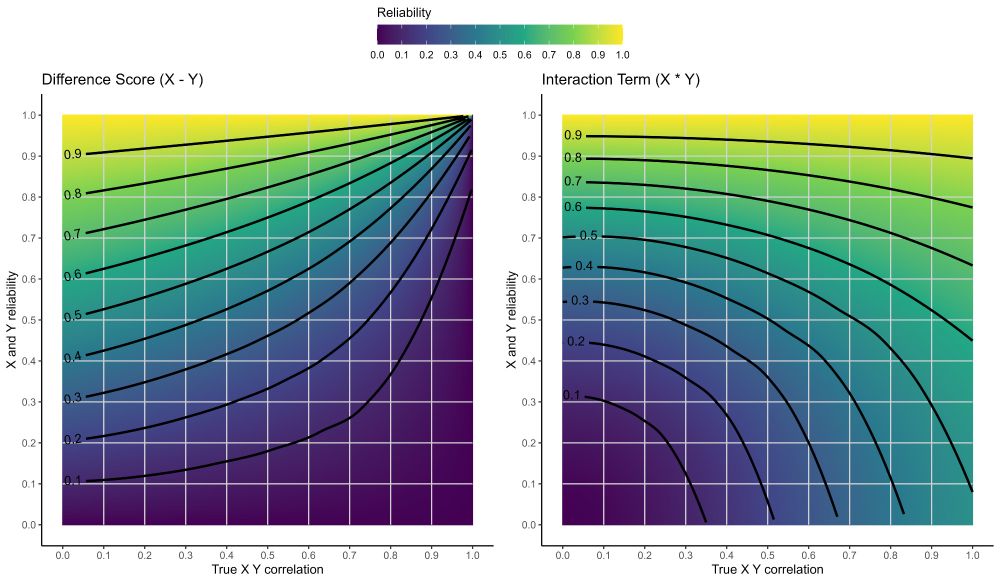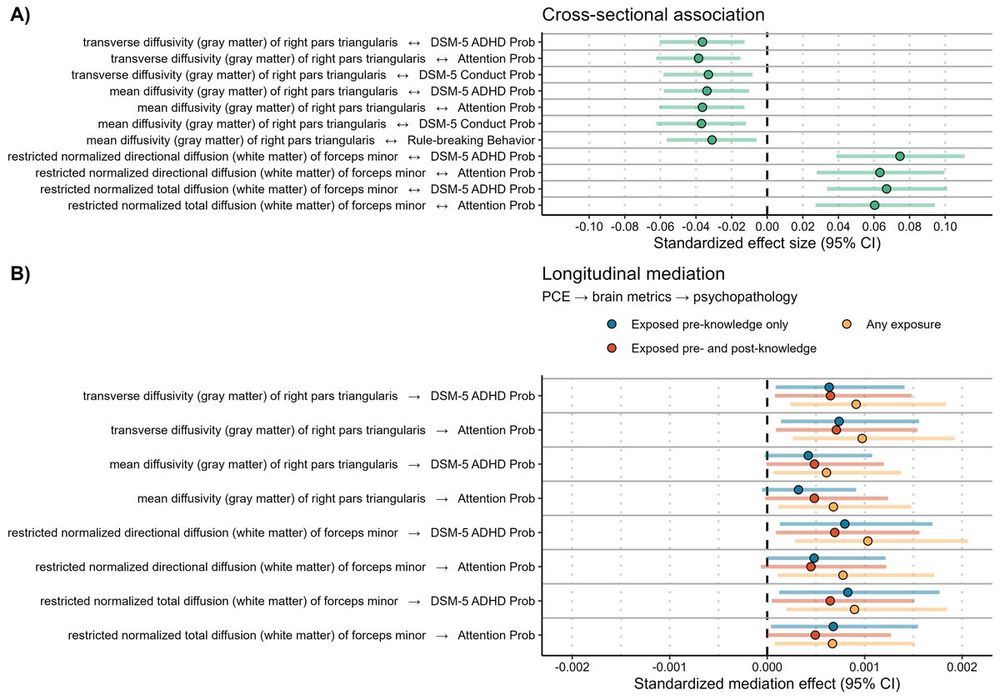
David Baranger
@davidbaranger.bsky.social
Assistant Professor at the Medical College of Wisconsin. 🧀
Substance use, neuroscience, genetics, & development. 🧠🧬🍺
Rock climber & dad. He/him. 🧗
Opinions my own. 🤔
bearlab.science 🐻
Substance use, neuroscience, genetics, & development. 🧠🧬🍺
Rock climber & dad. He/him. 🧗
Opinions my own. 🤔
bearlab.science 🐻
Shout out to BEAR Lab research tech Daniella Fernandez (who only joined 4 months ago!) whose poster abstract was selected for a nanosymposium at the annual meeting of the Upper Midwest Chapter of SFN this weekend! #neuroskyence #MRI 🧠🍺


October 27, 2025 at 8:20 PM
Shout out to BEAR Lab research tech Daniella Fernandez (who only joined 4 months ago!) whose poster abstract was selected for a nanosymposium at the annual meeting of the Upper Midwest Chapter of SFN this weekend! #neuroskyence #MRI 🧠🍺
I'm sorry, what is this scale????

May 13, 2025 at 2:41 PM
I'm sorry, what is this scale????
Reliability of a difference score vs. reliability of an interaction term.

April 28, 2025 at 9:52 PM
Reliability of a difference score vs. reliability of an interaction term.
Bryce Canyon, 2021

February 25, 2025 at 6:22 PM
Bryce Canyon, 2021
I am reminded of similar concerns regarding candidate genes (again, see my early work) and similarly wonder how much signal vs. noise would be thrown out. The approach I describe is a global analysis, and I think our results support the hypothesis that that is a reasonable approach for this task...


February 2, 2025 at 7:30 PM
I am reminded of similar concerns regarding candidate genes (again, see my early work) and similarly wonder how much signal vs. noise would be thrown out. The approach I describe is a global analysis, and I think our results support the hypothesis that that is a reasonable approach for this task...
But what if you don't have thousands and thousands of participants? This is where neural signatures really shine. We find that you only need a couple hundred participants to train a model that achieves near-peak performance!

February 1, 2025 at 8:04 PM
But what if you don't have thousands and thousands of participants? This is where neural signatures really shine. We find that you only need a couple hundred participants to train a model that achieves near-peak performance!
How do signatures compare with a standard machine learning analysis? Using the full sample, we compared to an elastic-net model, finding that the signature was slightly worse at predicting cognition, but better at predicting psychopathology! The two approaches also capture non-overlapping variance.

February 1, 2025 at 8:04 PM
How do signatures compare with a standard machine learning analysis? Using the full sample, we compared to an elastic-net model, finding that the signature was slightly worse at predicting cognition, but better at predicting psychopathology! The two approaches also capture non-overlapping variance.
But what do neural signature associations mean? Intriguingly, they correspond to the correlation between the main effect of task map and the individual difference (BWAS) map. So they tell you whether regions that change with the task are positively or negatively correlated with your trait!

February 1, 2025 at 8:04 PM
But what do neural signature associations mean? Intriguingly, they correspond to the correlation between the main effect of task map and the individual difference (BWAS) map. So they tell you whether regions that change with the task are positively or negatively correlated with your trait!
What's more, the neural signature predictions were *more* reliable than activation in individual regions and *more* sensitive to individual differences across 33 measures!


February 1, 2025 at 8:04 PM
What's more, the neural signature predictions were *more* reliable than activation in individual regions and *more* sensitive to individual differences across 33 measures!
But does this preliminary evidence generalize? Is this an approach that anyone with task fMRI data could use? To find out, we trained a working memory signature in the ABCD study (N=9,024). The classifier performed well and captured the known neurobiology of working memory.

February 1, 2025 at 8:04 PM
But does this preliminary evidence generalize? Is this an approach that anyone with task fMRI data could use? To find out, we trained a working memory signature in the ABCD study (N=9,024). The classifier performed well and captured the known neurobiology of working memory.
Task fMRI is very useful for localization and understanding neural computations, but less so for studies of differences *between* people, largely because it is less reliable than we thought (Elliott 2020 is the canonical citation pubmed.ncbi.nlm.nih.gov/32489141/)

February 1, 2025 at 8:04 PM
Task fMRI is very useful for localization and understanding neural computations, but less so for studies of differences *between* people, largely because it is less reliable than we thought (Elliott 2020 is the canonical citation pubmed.ncbi.nlm.nih.gov/32489141/)
Bookmark for all future grants: Use of Promotional Language in Grant Applications and Grant Success: "the percentage of promotional words was positively associated with the probability of receiving funding (NIH grants: odds ratio, 1.51 [95% CI, 1.10-2.11])." jamanetwork.com/journals/jam...

December 11, 2024 at 10:53 PM
Bookmark for all future grants: Use of Promotional Language in Grant Applications and Grant Success: "the percentage of promotional words was positively associated with the probability of receiving funding (NIH grants: odds ratio, 1.51 [95% CI, 1.10-2.11])." jamanetwork.com/journals/jam...
Distracting myself from current events by spending too long on this figure. 😅

November 5, 2024 at 8:57 PM
Distracting myself from current events by spending too long on this figure. 😅
Our article exploring the neurobiological correlates of prenatal cannabis exposure is now out! "Prenatal cannabis exposure, the brain, and
psychopathology during early adolescence" https://rdcu.be/dMJqH
psychopathology during early adolescence" https://rdcu.be/dMJqH

July 8, 2024 at 2:26 PM
Our article exploring the neurobiological correlates of prenatal cannabis exposure is now out! "Prenatal cannabis exposure, the brain, and
psychopathology during early adolescence" https://rdcu.be/dMJqH
psychopathology during early adolescence" https://rdcu.be/dMJqH
Stoked for my first APS #APS24SF! I'll be presenting on our InteractionPoweR #rstats package in an invited session on sample size planning!


May 22, 2024 at 6:27 PM
Stoked for my first APS #APS24SF! I'll be presenting on our InteractionPoweR #rstats package in an invited session on sample size planning!
@Alex_PMiller And at the regional level, we see expected decreases (i.e., frontal cortex thickness), but otherwise lots of regions also show *increases* relative to participants with no substance use initiation!

March 13, 2024 at 2:19 PM
@Alex_PMiller And at the regional level, we see expected decreases (i.e., frontal cortex thickness), but otherwise lots of regions also show *increases* relative to participants with no substance use initiation!
@Alex_PMiller A bit more about why I really like this paper: this isn't a drugs = smaller brain story. In fact, we mostly see that substance use is associated with *larger* brain metrics!

March 13, 2024 at 2:17 PM
@Alex_PMiller A bit more about why I really like this paper: this isn't a drugs = smaller brain story. In fact, we mostly see that substance use is associated with *larger* brain metrics!
From the supplement of the paper I'm writing - 2-year longitudinal stability of Neuroimaging IDPs from the ABCD study.

January 18, 2024 at 7:17 PM
From the supplement of the paper I'm writing - 2-year longitudinal stability of Neuroimaging IDPs from the ABCD study.
A quick data simulation/visualization about being cautious when using difference scores.

December 7, 2023 at 9:09 PM
A quick data simulation/visualization about being cautious when using difference scores.
Interestingly, a few of these measures are correlated with adolescent psychopathology (externalizing), including two of the ones that survived more stringent correction, and longitudinal mediation analyses were significant for attention/ADHD

September 20, 2023 at 8:14 PM
Interestingly, a few of these measures are correlated with adolescent psychopathology (externalizing), including two of the ones that survived more stringent correction, and longitudinal mediation analyses were significant for attention/ADHD
These were mostly measures from diffusion imaging, but included not only white matter tracts, but also measures of both cortical grey and white matter.

September 20, 2023 at 8:14 PM
These were mostly measures from diffusion imaging, but included not only white matter tracts, but also measures of both cortical grey and white matter.
Only 3 associations survived correction for multiple tests, and 14 more survived a less stringent correction.

September 20, 2023 at 8:14 PM
Only 3 associations survived correction for multiple tests, and 14 more survived a less stringent correction.
It's official!!🎉I got my NOA for my K99/R00 from @NIAAAnews . Really looking forward to starting this project.
Also, seems like a good time to share that I'll be on the job market this year! I study alcohol and substance use across development with neuroimaging and genetics.
Also, seems like a good time to share that I'll be on the job market this year! I study alcohol and substance use across development with neuroimaging and genetics.

August 21, 2023 at 4:34 PM
It's official!!🎉I got my NOA for my K99/R00 from @NIAAAnews . Really looking forward to starting this project.
Also, seems like a good time to share that I'll be on the job market this year! I study alcohol and substance use across development with neuroimaging and genetics.
Also, seems like a good time to share that I'll be on the job market this year! I study alcohol and substance use across development with neuroimaging and genetics.
The unreliability of difference scores seems to be a recent theme for me. This figure underscores why.

May 5, 2023 at 3:50 PM
The unreliability of difference scores seems to be a recent theme for me. This figure underscores why.
Inspired by a fun conversation with @ThomasIsPsyched, the InteractionPoweR Shiny app for analytic power analyses now includes the option to simulate and visualize single data sets. Available at https://david-baranger.shinyapps.io/InteractionPoweR_analytic/

April 19, 2023 at 12:17 AM
Inspired by a fun conversation with @ThomasIsPsyched, the InteractionPoweR Shiny app for analytic power analyses now includes the option to simulate and visualize single data sets. Available at https://david-baranger.shinyapps.io/InteractionPoweR_analytic/

